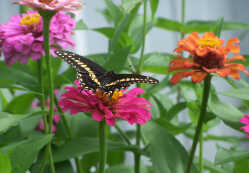Beating the Heat and Enjoying Butterflies

Hot weather calls for some creative ways to beat the heat, especially when working with cattle. We decided to spray for flies beginning at 9 p.m. since we have lights in the barn. Our daughter agreed to help. It had cooled off some and a good breeze was blowing so we proceeded. It really worked out well except for one almost major problem.
We needed a place to put those that had eye problems so that we could medicate them after we finished spraying. It was dark by then and the yard light only reached so far, but we had some moonlight. I closed one gate on the pen and was trying to get the other side closed when I noticed a white faced animal reflected in the moonlight. I thought it was the dog and tugged on the gate some more. Then the dog moved--and it was on the other side of me from the other animal. I peered into the musky light and my heart almost stopped. I was almost face-to-face with a skunk! I froze in place and breathed a prayer that the dog would leave it alone--and that the skunk would not do what comes naturally. Slowly, I slunk back to the barn, and it went on its night excursion without spraying me. Whew! That was too close for comfort. That gate never did get closed. We used another pen, but after we finished, I had to go open the gate that I had closed as there were calves in there that couldn't get to water. I never had any more meetings with my moonlight friend, and that was just fine with me. We finished about 1 a.m., but that was lots better than trying to work in the heat and hot sunshine.
A few nights later, our daughter returned the favor by calling at 9 p.m. saying she had some buckets of sweet corn she had picked from her garden. It was after midnight when we finished cutting it from the cob and getting it prepared and into the freezer. But it will be wonderful to eat next winter and we didn't have to work in the heat fixing it.
These aren't much in the way of tips to beat the heat; they are more in the line of survival. Extreme heat is as dangerous as freezing, so we must all use caution.
One thing that I've particularly enjoyed watching this week was the butterflies in my zinnias and reading some things about them.
More than 12,000 different kinds of butterflies are fluttering around on earth today. The orange-and-black monarchs fly up to 5,000 miles round-trip each year to spend the winter in one secluded area--the High Sierra mountains of Mexico, about 80 miles west of Mexico City. In the summer months, however, monarchs can be found as far north as Canada. As they migrate, monarchs may reach a top speed of 35 miles an hour--some have been discovered to fly 265 miles in a single day. The average migration trip takes about 40 days. Imagine 40 days of fluttering.
While in the Mexican mountains, more than 10,000 feet above sea level, the monarchs--about 300 million of them--rest on thick fir trees. The monarchs that leave Mexico lay eggs in places such as Texas and Louisiana, and it is their offspring who, after transforming themselves from caterpillars to butterflies, fly on as far north as Canada and then begin the trip to Mexico the following August.
The female Queen Alexandra birdwing butterfly of New Guinea is considered the world's largest butterfly with a wingspan of more than 11 inches. I've never seen one that big, but we went to the Butterfly House in Branson and saw lots of different kinds.
I love the beautiful butterflies because they remind me of the death, burial and resurrection of Jesus. From a lowly caterpillar to a cocoon, to a dazzling butterfly--what a miracle.
